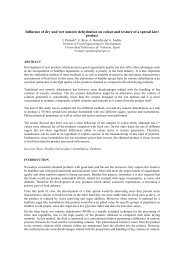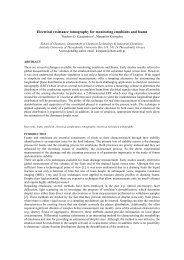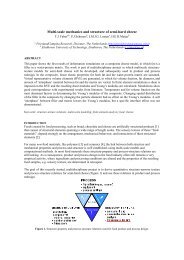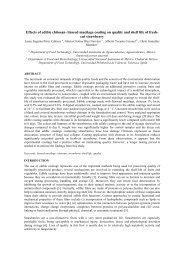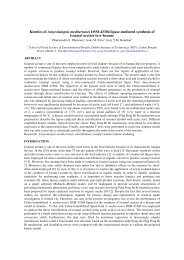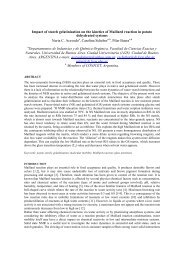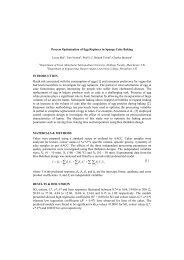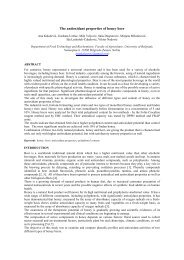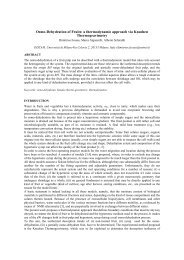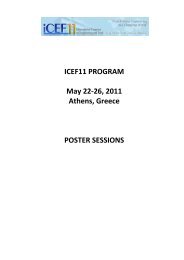Finite element modelling of fish cooking by microwave - 11th ...
Finite element modelling of fish cooking by microwave - 11th ...
Finite element modelling of fish cooking by microwave - 11th ...
Create successful ePaper yourself
Turn your PDF publications into a flip-book with our unique Google optimized e-Paper software.
<strong>Finite</strong> Element Modelling <strong>of</strong> Fish Cooking <strong>by</strong> Microwave<br />
Shixiong Liu, Mika Fukuoka, Noboru Sakai*<br />
Department <strong>of</strong> Food Science and Technology<br />
Tokyo University <strong>of</strong> Marine Science and Technology<br />
4-5-7 Konan, Minato-ku, Tokyo, Japan, 108-8477<br />
sakai@kaiyodai.ac.jp (N. Sakai).<br />
ABSTRACT<br />
Three-dimensional finite <strong>element</strong> models <strong>of</strong> solid food in <strong>microwave</strong> oven has been built to predict food<br />
temperature distribution during <strong>microwave</strong> <strong>cooking</strong> <strong>by</strong> using commercial s<strong>of</strong>tware FEMAP (Siemens Co.<br />
Ltd.), which is a kind <strong>of</strong> pre-processor. The temperature distribution <strong>of</strong> food was simulated, based on heat<br />
transfer equation including the internal heat generation owing to <strong>microwave</strong> heating. To obtain the internal<br />
heat generation, the distribution <strong>of</strong> <strong>microwave</strong> electric field in the oven was estimated <strong>by</strong> using PHOTO-<br />
Wavejω (Photon Co. Ltd.).<br />
Mashed potato with 1wt % sodium chloride, 1wt % salted water were used as solid material and liquid<br />
material for experimental validation. The input <strong>microwave</strong> power <strong>of</strong> 600W was used for heating. Results<br />
showed good agreement between the experimental data and predicted values <strong>of</strong> temperatures. Finally, a<br />
model for <strong>fish</strong> <strong>cooking</strong> in salted water had been built for predicting temperature distribution during<br />
<strong>microwave</strong> heating.<br />
Keywords: Microwave <strong>cooking</strong>; Dielectric properties; <strong>Finite</strong> <strong>element</strong> analysis; Electromagnetic field analysis;<br />
Temperature distribution<br />
INTRODUCTION<br />
For its rapid heating and convenience, <strong>microwave</strong> heating is widely used in our daily life. However,<br />
disadvantages also exist, such as non uniform temperatures rising under <strong>microwave</strong> irradiation which depend<br />
on various factors. It demonstrates the necessity <strong>of</strong> producing an accurate model to predict the temperature<br />
distribution in the materials.<br />
Many researchers have been focused on temperature analysis <strong>of</strong> <strong>microwave</strong> heating which has been the<br />
biggest problem for <strong>modelling</strong> due to the non uniform temperature distribution. Models for temperature<br />
simulating for <strong>microwave</strong> heating had been built since 30 years ago [1]. With the rapid development <strong>of</strong><br />
computer technology, now most models were built based on commercial computer s<strong>of</strong>tware with analytical<br />
and numerical techniques [2], and complex mathematic analytical methods were brought in to use. Some<br />
researchers simulated models <strong>by</strong> analyzing heat and mass transfer and used Lambert’s law for assuming a<br />
source term with exponential decay [3]. Others analyzed models <strong>by</strong> coupling the heat transfer and<br />
electromagnetic equations (Maxwell’s equation) such as FDTD (finite deference time domain) [4] and FEM<br />
(finite <strong>element</strong> method) [5] analytical method.<br />
As conditions are intricate, few studies could be found on simulating <strong>microwave</strong> <strong>cooking</strong>. Although lots <strong>of</strong><br />
models had been built to predict the <strong>microwave</strong> heating in the past decades, conditions <strong>of</strong> <strong>microwave</strong> heating<br />
such as the shape and the size <strong>of</strong> <strong>microwave</strong> oven cavity and existence <strong>of</strong> turntable in cavity had always been<br />
selectively neglected in these studies. More importantly, dielectric properties <strong>of</strong> materials actually were<br />
changed with the temperatures during <strong>cooking</strong>. However, they were all regarded as the constant in most <strong>of</strong><br />
the studies due to the great difficulties <strong>of</strong> simulating heating including all <strong>of</strong> these factors together in a 3D<br />
model. As few research has been found on predicting heating the mixture <strong>of</strong> solid and liquid <strong>by</strong> <strong>microwave</strong><br />
simultaneously, a more considerable and more accurate 3D model needs to be built for simulating this kind <strong>of</strong><br />
<strong>microwave</strong> heating.<br />
Marine <strong>fish</strong>es which are good to human’s health have a large number <strong>of</strong> stable consumers in the world,<br />
especially in Japan, while Japanese has the custom <strong>of</strong> eating <strong>fish</strong> that cooked in salted decoction. However,<br />
few studies could be found on investigating or <strong>modelling</strong> <strong>cooking</strong> <strong>fish</strong> <strong>by</strong> using <strong>microwave</strong>. In this study, we<br />
investigated the <strong>cooking</strong> <strong>of</strong> <strong>fish</strong>, using salmon (Atlantic salmon) as the sample which is one <strong>of</strong> the most<br />
popular marine <strong>fish</strong>es for its delicious taste and health benefits.<br />
1
Objective <strong>of</strong> this study is to build a 3D finite <strong>element</strong> model for simulating <strong>fish</strong> <strong>cooking</strong> under <strong>microwave</strong><br />
irradiation. Real experimental environment for <strong>microwave</strong> heating would be considered, mixture <strong>of</strong> solid<br />
(<strong>fish</strong>) and liquid (water) would be heated and simulated in this simulation. Temperature distribution <strong>of</strong> the<br />
sample have been investigated, based on heat transfer equation including the internal heat generation which<br />
was obtained <strong>by</strong> analyzing <strong>of</strong> electromagnetic field.<br />
MATERIALS & METHODS<br />
For experimental validation, mashed potato with 1wt % sodium chloride and 1wt % salted water were used as<br />
solid material and liquid material, respectively. Microwave <strong>of</strong> 600W output at the frequency <strong>of</strong> 2450MHz<br />
was used for heating, Initial temperature <strong>of</strong> the environment is 15˚ C, <strong>microwave</strong> transmitted in a waveguide<br />
that designed to transmit maximum possible power. In this kind <strong>of</strong> waveguide, the dominant mode <strong>of</strong> the<br />
transverse electric wave is the TE 10 mode [6]. Finally, a model for <strong>fish</strong> <strong>cooking</strong> in salted water had been built<br />
for predicting temperature distribution during <strong>microwave</strong> heating.<br />
The 3D <strong>Finite</strong> <strong>element</strong> model following the real structure including sample, turntable, and <strong>microwave</strong> oven<br />
were made <strong>by</strong> pre-processor s<strong>of</strong>tware. The distribution <strong>of</strong> <strong>microwave</strong> electric field and the internal heat<br />
generation in the oven was estimated <strong>by</strong> using PHOTO-Wavejω (Photon Co. Ltd.). The electromagnetic field<br />
distribution inside the product is solved according to the theory <strong>of</strong> Maxwell’s equations. The governing<br />
equations for a propagating electromagnetic wave in different form are written as the followings [6]:<br />
∇ ⋅ E = − jωµ<br />
H<br />
(1)<br />
∇ ⋅ H = j εE<br />
(2)<br />
ωε 0<br />
∇ ⋅ E = 0<br />
(3)<br />
∇ ⋅ H = 0<br />
(4)<br />
In the equations <strong>of</strong> (1) to (4), E is the electric field intensity; H is the magnetic field intensity. µ is<br />
permeability <strong>of</strong> free space (4π×10 -7 H/m), ɷ is angular frequency (rad/s), ε 0 is the permittivity <strong>of</strong> free space<br />
(8.85 ×10 -12 F m -1 ), ε is the complex permittivity, andε′ is the dielectric constant while ε ′ is the dielectric<br />
loss factor with j 2 =-1.<br />
jωt<br />
E( x,<br />
y,<br />
z,<br />
t)<br />
= E0(<br />
x,<br />
y,<br />
z)<br />
e<br />
(5)<br />
jωt<br />
H ( x,<br />
y,<br />
z,<br />
t)<br />
= H<br />
0<br />
( x,<br />
y,<br />
z)<br />
e<br />
(6)<br />
' ''<br />
ε = ε − jε<br />
(7)<br />
The energy <strong>of</strong> <strong>microwave</strong> which is transmitted through a rectangular wave guide along the z-direction<br />
distributed in the shape <strong>of</strong> sine curve. Electric intensity <strong>of</strong> <strong>microwave</strong> at different position could be calculated<br />
<strong>by</strong> using following equations:<br />
Z0<br />
E 2<br />
ab<br />
P<br />
t<br />
max = (8)<br />
λ 2<br />
Z<br />
0<br />
377/ 1−<br />
(<br />
λ c<br />
)<br />
= (9)<br />
Where, a, b are the size <strong>of</strong> wave guide, P is the <strong>microwave</strong> power, Z 0 is the wave characteristic impedance,<br />
and λ is the <strong>microwave</strong> length <strong>of</strong> 147.9 (mm), which transmitted in the wave guide size <strong>of</strong> 109.2×54.6 (mm),<br />
λ c is the wave length <strong>of</strong> <strong>microwave</strong> in free space. Here, λ c = 2Y = 218.4 (mm). Boundary conditions on the<br />
inner wall surface <strong>of</strong> the oven cavity could be described in equation (11)<br />
yπ<br />
E x<br />
= Emax<br />
sin( )<br />
(10)<br />
y0<br />
E = 0 = 0<br />
tan<br />
H<br />
n<br />
(11)<br />
Microwave heating involves EM interaction <strong>of</strong> the lossy material (dielectric material having considerable<br />
power dissipation capability) placed between the two plate electrodes. The absorbed MW power per unit<br />
volume (Q, W m -3 ) in the material is proportional to the square <strong>of</strong> the electric field strength (E, V m<br />
-1 ) and<br />
directly proportional to the dielectric loss factor (E, Vm -1 ) and the frequency (f, Hz). E rms is the root mean<br />
square value <strong>of</strong> the electric field which is equal to 1/ times <strong>of</strong> the E-field amplitude as shown in equation<br />
(12) [7].<br />
2 ''<br />
2<br />
Q( x,<br />
y,<br />
z,<br />
t)<br />
= 2π fErms ε ε = πfε<br />
ε '' E (12)<br />
0<br />
0<br />
2
Dielectric properties <strong>of</strong> 1wt % salted mashed potato, 1 wt % salted water and Atlantic salmon has been<br />
measured <strong>by</strong> using dielectric constant equipment (HP85070B; Hewlett-Packard Corp., Santa Rosa, CA, USA)<br />
at varied temperatures in a constant temperature and humid chamber (SH-240; Espec Corp., Osaka). Then,<br />
Penetration depth had been calculated <strong>by</strong> following equation (13).<br />
0.5<br />
λ ⎛ 2<br />
4<br />
2<br />
'( 1 ( ''/<br />
') 1)<br />
⎟ ⎟ ⎞<br />
d = ⎜<br />
π ⎜<br />
⎝ ε + ε ε − ⎠<br />
(13)<br />
Temperature distributions <strong>of</strong> food were simulated based on Three-dimensional heat transfer equation<br />
including the internal heat generation owing to <strong>microwave</strong> heating. Heat conduction equation including the<br />
heat generation was described in Eq. (12). Q em is the internal heat generation source <strong>of</strong> food, which quantifies<br />
the amount <strong>of</strong> power that dissipated in the sample <strong>by</strong> dielectric losses.<br />
∂T<br />
ρ C<br />
p<br />
= ∇(<br />
k∇T<br />
) + Q em<br />
(12)<br />
∂t<br />
Experiment <strong>of</strong> <strong>microwave</strong> heating had also been done at the same time. Temperature measuring system<br />
(LUXTRON 712; LumaSense Technologies Inc., Santa Clara, California) with optical fibre sensor was used<br />
to measure and record the temperature histories, while image <strong>of</strong> temperature distribution was captured <strong>by</strong><br />
infrared thermal camera.<br />
RESULTS & DISCUSSION<br />
As both solid and liquid materials were contented in the model for simulating <strong>fish</strong> <strong>cooking</strong>, we first used<br />
simple materials <strong>of</strong> solid and liquid separately for simulation and experiment for validation.<br />
Figure 1. Schematic <strong>of</strong> <strong>microwave</strong> heating system and container size<br />
Simulation and experiment on heating solid material under <strong>microwave</strong> irradiation were carried out <strong>by</strong> using 1<br />
wt % salted mashed potato. Container full filled with mashed potato that located on the turntable in<br />
<strong>microwave</strong> oven (270 mm×270 mm×185 mm) was rotated and heated for 190s (The continuous rotation<br />
speed is 0.2 π/s) as shown in Fig. 1. Dielectric properties have been measured and shown in Table 1.<br />
Table 1 Dielectric property <strong>of</strong> 1 wt % salted mashed potato<br />
Temperature (˚C) 20.00 30.00 40.00 50.00 60.00 70.00 80.00 90.00<br />
Dielectric constant 54.73 52.67 51.02 49.30 46.86 42.81 33.35 27.28<br />
Dielectric loss 20.26 19.95 19.54 18.79 18.22 18.00 15.35 13.79<br />
Penetration depth (cm) 0.72 0.72 0.72 0.74 0.74 0.72 0.75 0.76<br />
Dielectric properties were used as temperature dependent during heating in simulation 1. Heat generation<br />
result <strong>of</strong> simulation showed the significant change from top to bottom due to the location <strong>of</strong> wave guide and<br />
the sample size. Temperature distribution <strong>of</strong> sample on surfaces <strong>of</strong> horizontal cross-section had been<br />
observed to validate the calculation data. Predicted results and experimental results <strong>of</strong> temperature<br />
distribution were compared while good agreements have been shown in Fig. 2.<br />
As there’s almost no change in penetration depths <strong>of</strong> this material at different temperatures showed in Fig. 1,<br />
heat generation distribution were considered as the same at any temperature. We assumed that there would be<br />
same temperature distribution results inside sample which simulated <strong>by</strong> using the dielectric properties <strong>of</strong> any<br />
one <strong>of</strong> the certain temperatures as constant. Dielectric property at 20 ˚C was then used as the constant for<br />
3
testing (simulation 2). No significant difference could be observed between simulation 1 and 2 as showed in<br />
Fig. 2, which means, simulation could be simplified <strong>by</strong> regarding dielectric properties as constant if<br />
penetration depth <strong>of</strong> this material doesn’t change with temperature.<br />
Figure 2. Comparison <strong>of</strong> simulating and measured temperature distribution on middle surface<br />
From Fig. 3, penetration depths <strong>of</strong> all the three different materials were observed that there is nearly no<br />
change at different temperatures. Therefore, we would use the dielectric properties <strong>of</strong> 20 ˚C (Table. 2) <strong>of</strong> all<br />
the three materials as the constant value in the following simulating.<br />
Table 2. Dielectric properties <strong>of</strong> 1% salted mashed potato and water<br />
Dielectric properties Mashed potato Water<br />
Atlantic salmon<br />
(20˚C) (1wt % salted) (1wt % salted)<br />
ε ’ 54.73 74.44 43.46<br />
ε ’’ 20.25 23.97 13.63<br />
Figure 3. Penetration depth <strong>of</strong> the three materials at different temperature<br />
1wt % salted water was then used as the material <strong>of</strong> liquid for simulating and experiment validation. During<br />
heating, convection inside water can easily occur which has to be considered in our simulation. If the real<br />
value <strong>of</strong> thermal properties <strong>of</strong> water was used in simulating temperature distribution <strong>of</strong> water under<br />
<strong>microwave</strong> irradiation as the usual way, hot spot inside the water would be founded in the results <strong>of</strong><br />
simulation, which means non-uniform temperature inside the water (Fig. 4, simulation p1’ and simulation<br />
P2’). And, temperature difference will become bigger as time steps pasted. However, from the real<br />
experiment, temperatures inside water were observed being uniform as convection occurred during heating.<br />
Solution has been proposed <strong>by</strong> assuming water as a material <strong>of</strong> much more bigger thermal conductivity.<br />
Equals to the effect <strong>of</strong> convection, the heat would transfer very fast during heating while temperature would<br />
be averaged quickly in a result.<br />
As the model that we used before for simulating mashed potato had been confirmed <strong>by</strong> experiment, it would<br />
be used again <strong>by</strong> changing the material property into 1 wt % water for simulating while experiment would be<br />
done at the same time to find out the suitable thermal conductivity setting for water in simulation. And, as the<br />
convection occurs inside water that averaged the temperature, rotation would not be considered here in both<br />
experiment and simulating. Good results <strong>of</strong> uniformed temperature showed in simulation demonstrated that<br />
thermal conductivity <strong>of</strong> water <strong>of</strong> 1000 times’ bigger was suitable for our simulation. By comparing with<br />
4
experiment data, temperature results inside water (1 wt % salted) <strong>of</strong> prediction were found to meet with it<br />
very well (300s) (Figure 4) in the condition <strong>of</strong> setting thermal conductivity <strong>of</strong> water into 1000 times’ bigger.<br />
Figure 4. Temperature comparing <strong>of</strong> assigned point between simulation and experiment<br />
Finally, a model for simulating <strong>cooking</strong> <strong>fish</strong> in 1 wt % salted water had been built (Figure 5). Atlantic salmon<br />
in rectangular shape was located inside the water in the container for <strong>microwave</strong> (600 W) heating for 300s.<br />
Rotation would not considered in this model due to the including material <strong>of</strong> water and the shape <strong>of</strong> container.<br />
Figure 5. Schematic <strong>of</strong> <strong>fish</strong> <strong>cooking</strong> model (half)<br />
Table 3. Thermal properties <strong>of</strong> different materials<br />
Thermal conductivity Specific heat<br />
Material<br />
(W/m/K) (J/K/Kg)<br />
Density<br />
(Kg/m 3 )<br />
Container 0.2 1800 905<br />
Salmon 0.47 3589 1050<br />
Water (1 wt % Salted) 600 (Real : 0.6) 4200 1000<br />
Turn table 1.05 840 2230<br />
Air 0.024 1000 1.3<br />
Figure 6. Heat generation <strong>of</strong> Atlantic salmon and water<br />
5
Figure 7. Temperature distribution <strong>of</strong> Atlantic salmon and NaCl-water solution in longitudinal section (190s)<br />
Table 3 shows the parameter <strong>of</strong> thermal properties <strong>of</strong> different materials we used for simulating. Heat<br />
generation and temperature has been simulated, temperature distribution inside sample could be easily<br />
showed and observed in colour figures (Figure 6 and Figure 7).<br />
CONCLUSION<br />
Models for predicting temperature <strong>of</strong> solid and liquid materials under <strong>microwave</strong> irradiation had been<br />
validated separately <strong>by</strong> using mashed potato (1 wt % salted) and water (1 wt % salted) with experimental<br />
measurements. For solid material, good agreement has been found between simulation and experimental<br />
results. For liquid material, as the convection occurred inside the water during heating, 1000 bigger value <strong>of</strong><br />
thermal conductivity <strong>of</strong> water has been set in the simulation. Equals to the effect <strong>of</strong> the convection,<br />
simulation results meets the experiment histories very well. Consequently, methods <strong>of</strong> this study for<br />
modeling <strong>microwave</strong> heating could be used to predict temperature distributions <strong>of</strong> sample accurately in<br />
which penetration depth <strong>of</strong> <strong>microwave</strong> do not change significantly during heating.<br />
Finally, a three-dimensional finite <strong>element</strong> model for modeling <strong>fish</strong> <strong>cooking</strong> inside salted water under<br />
<strong>microwave</strong> irradiation has been developed to predict heat generation distribution and temperature distribution<br />
inside <strong>fish</strong> and water during <strong>microwave</strong> heating. Internal heat generation was simulated <strong>by</strong> analyzing the<br />
electric field distribution in the <strong>microwave</strong> oven. Temperature distribution <strong>of</strong> food was simulated based on<br />
heat transfer equation including the internal heat generation owing to <strong>microwave</strong> heating. Temperature<br />
distribution inside sample could be easily showed and observed in colour figures.<br />
REFERENCES<br />
[1] Watanabe, W. & Ohkawa, S. 1978. Analysis <strong>of</strong> power density distribution in <strong>microwave</strong> ovens. Journal <strong>of</strong> <strong>microwave</strong><br />
Power and Electromagnetic Energy, 13(2), 173-182.<br />
[2] L.Zhou & G.Yeh 1995. <strong>Finite</strong> Element Modeling <strong>of</strong> Heat and Mass Transfer in Food Materials during Microwave<br />
Heating- Model Development and Validation. Journal <strong>of</strong> Food Engineering, 25(4), 509-529.<br />
[3] H. Ni & A. k. Datta 1999. Moisture transport in intensive <strong>microwave</strong> heating <strong>of</strong> biomaterials: A multiphase porous<br />
media model. International Journal <strong>of</strong> Heat and Mass Transfer, 42(8), 1501-1512.<br />
[4] H. Chen & F. Liu 2008. Simulation model for moving food packages in <strong>microwave</strong> heating processes using<br />
conformal FDTD method. Journal <strong>of</strong> Food Engineering, 88(3), 294-305.<br />
[5] R.B. Pandit & Suresh Prasad 2003. <strong>Finite</strong> <strong>element</strong> analysis <strong>of</strong> <strong>microwave</strong> heating <strong>of</strong> potato-transient temperature<br />
pr<strong>of</strong>iles. Journal <strong>of</strong> Food Engineering, 60(2), 193-202.<br />
[6] S.S.R. Geedipalli & A. K. Datta 2007. Modeling the heating uniformity contributed <strong>by</strong> a rotating turntable in<br />
<strong>microwave</strong> ovens. Journal <strong>of</strong> Food Engineering, 82(3), 359-368.<br />
[7] S.L. Birla & J. Tang 2008. Computer simulation <strong>of</strong> radio frequency heating <strong>of</strong> model fruit immersed in water. Jounal<br />
<strong>of</strong> Food Engineering, 84(2), 270-280.<br />
[8] L. A. Campanone & N. E. Zaritzky 2005. Mathematical analysis <strong>of</strong> <strong>microwave</strong> heating process. Journal <strong>of</strong> Food<br />
Engineering, 69(3), 359-368.<br />
6



